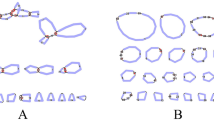Summary
Hemoglobin genes from plants and animals both have a characteristic chromosomal organization. Plant hemoglobin genes contain a unique intron inserted into the heme-binding domain of exon 2. This intron has not been previously reported in animal globin genes, and its loss was hypothesized to have occurred early in the evolution of hemoglobins. We report here a unique six-intron, seven-exon internally duplicated nematode hemoglobin gene that contains an intron equivalent to the plant central intron in its first repeat. This nematode hemoglobin gene has lost both the central and the normal third intron in its second repeat. The nematode globin also contains a unique intron between its secretory peptide leader sequence and its coding sequence, which is absent in other extracellular invertebrate globin genes. Possible models to explain the head-to-tail duplication of this gene are discussed.
Similar content being viewed by others
References
Antoine M, Niessing J (1984) Intron-less globin genes in the insect Chironomus thummi thummi. Nature 310:795–798
Antoine M, Erbil C, Munch E, Schnell S, Niessing J (1987) Genomic organization and primary structure of five homologous pairs of intron-less genes encoding secretory globins from the insect Chironomus thummi thummi. Gene 56:41–51
Blanchetot A, Wilson V, Wood D, Jeffreys AJ (1983) The seal myoglobin gene: an unusually long globin gene. Nature 301: 732–734
Bogusz D, Appleby CA, Landsmann J, Dennis ES, Trinick MJ, Peacock WJ (1988) Functioning haemoglobin genes in non-nodulating plants. Nature 331:178–180
Breathnach R, Chambon PA (1981) Organization and expression of eucaryotic split genes coding for proteins. Annu Rev Biochem 50:349–383
Dickerson RE, Geis I (1983) Hemoglobin: structure, function, evolution, and pathology. Benjamin Cummings, Menlo Park, p 97
Dixon B, Walker B, Kimmins W, Pohajdak B (1991) Isolation and sequencing of an unusual hemoglobin from the parasitic nematode Pseudoterranova decipiens. Proc Natl Acad Sci USA 88:5655–5659
Efstratiadis A, Posakony JW, Maniatis T, Lawn RM, O'Connell C, Spritz RA, DeRiel JK, Forget BG, Weissman SM, Slightom JL, Blechl AE, Smithies O, Baralle FE, Shoulders CC, Proudfoot NJ (1980) The structure and evolution of the human β-globin gene family. Cell 21:653–668
Frenkel MJ, Dopheide TAA, Wagland BM, Ward CW (1992) The isolation, characterization and cloning of a globin-like, host-protective antigen from the excretory-secretory products of Trichostrongylus colubriformis. Mol Biochem Parasitol 50: 27–36
Go M (1981) Correlation of DNA exonic regions with protein structural units in haemoglobin. Nature 291:90–92
Hardison RC (1991) Evolution of globin gene families. In: Selander RK, Clark AG, Whittam TS (eds) Evolution at the molecular level. Sinauer, Sunderland MA, pp 272–290
Jeffreys AJ (1981) In: Williamson R (ed) Genetic engineering, vol 2. Academic Press, New York, pp 1–48
Jensen EO, Paludan K, Hyldig-Neilsen JJ, Jorgensen P, Marcker KA (1981) The structure of a chromosomal leghaemoglobin gene from soybean. Nature 291:677–679.
Jhiang SM, Garey JR, Riggs AF (1988) Exon-intron organization in genes of earthworm and vertebrate globins. Science 240:334–336
Landsmann J, Dennis ES, Higgins TJV, Appleby CA, Krott AA, Peacock WJ (1986) Common evolutionary origin of legume and non-legume plant haemoglobins. Nature 324:166–168
Lewin R (1983) Surprise finding with insect globin genes. Science 219:1052–1054
Maniatis T, Fritsch EF, Aner J, Lawn RM (1980) The molecular genetics of human hemoglobins. Annu Rev Genet 14:145–178
Manning AM, Trotman CNA, Tate WP (1990) Evolution of a polymeric globin in the brine shrimp Artemia. Nature 348: 653–656
Naito Y, Riggs CK, Vandergon TL, Riggs AF (1991) Origin of a “bridge” intron in the gene for a two domain globin. Proc Natl Acad Sci USA 88:6672–6676
Nishioka Y, Leder A, Leder P (1980) Unusual α-globin-like gene that has cleanly lost both globin intervening sequences. Proc Natl Acad Sci USA 77:2806–2809
Sambrook J, Fritsch EF, Maniatis T (1989) Molecular cloning, ed 2. Cold Spring Harbor Laboratory Press, Cold Spring Harbor NY
Sanger F, Nicklen S, Coulson AR (1977) DNA sequencing with chain terminating inhibitors. Proc Natl Acad Sci USA 74: 5463–5467
Slightom JL, Blechl AE, Smithies O (1980) Human fetal Gγ-and Aγ-globin genes: complete nucleotide sequences suggest that DNA can be exchanged between these duplicated genes. Cell 21:627–638
Titchen DA, Glenn WK, Nassif N, Thompson AR, Thompson EOP (1991) A minor globin gene of the bivalve mollusc Anadara trapezia. Biochim Biophys Acta 1089:61–67
Vanin EF (1984) Processed pseudogenes. Biochim Biophys Acta 782:231–241
Vanin EF, Goldberg GI, Tucker PW, Smithies O (1980) A mouse α-globin-related pseudogene lacking intervening sequences. Nature 286:222–226
Zuckerman BM, Mai WF, Rohde RA (eds) (1971) Plant parasitic nematodes. Academic Press, New York
Author information
Authors and Affiliations
Additional information
Offprint requests to: B. Pohajdak
Rights and permissions
About this article
Cite this article
Dixon, B., Walker, B., Kimmins, W. et al. A nematode hemoglobin gene contains an intron previously thought to be unique to plants. J Mol Evol 35, 131–136 (1992). https://doi.org/10.1007/BF00183224
Received:
Revised:
Issue Date:
DOI: https://doi.org/10.1007/BF00183224




